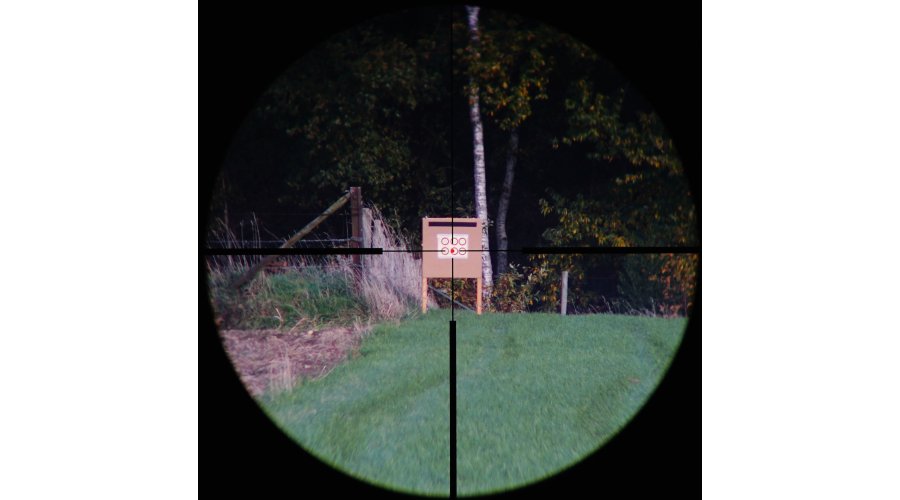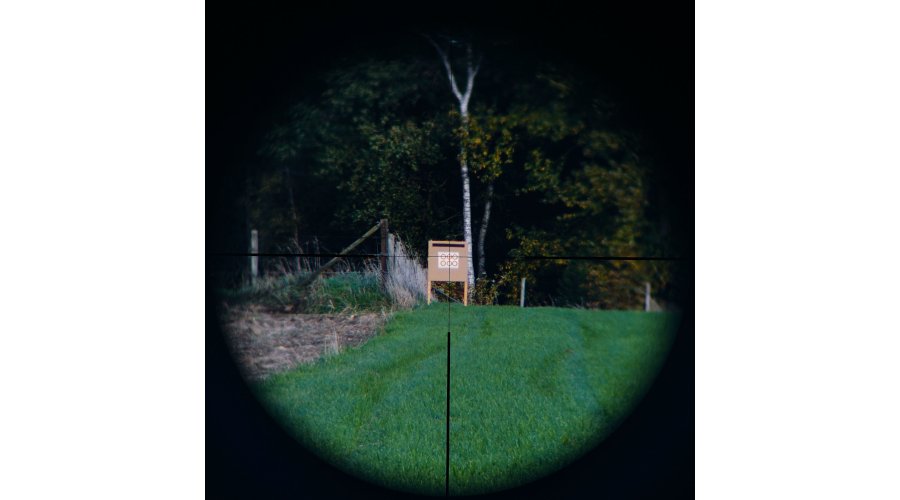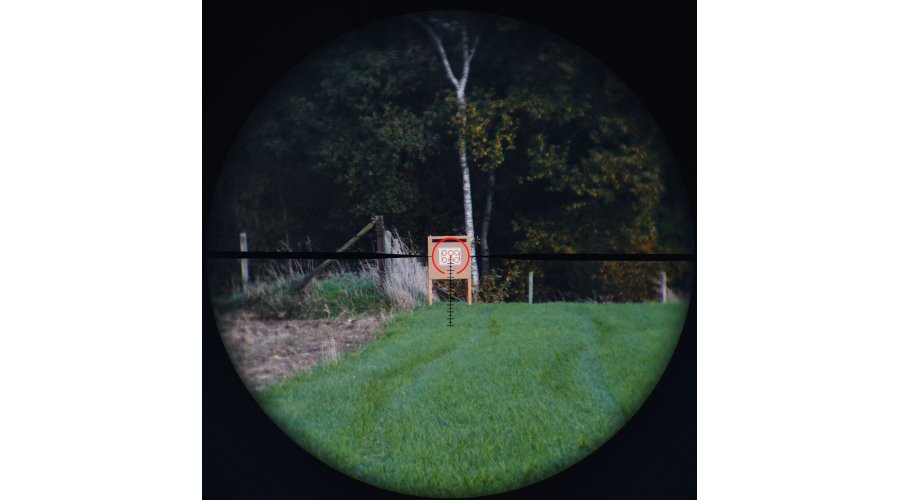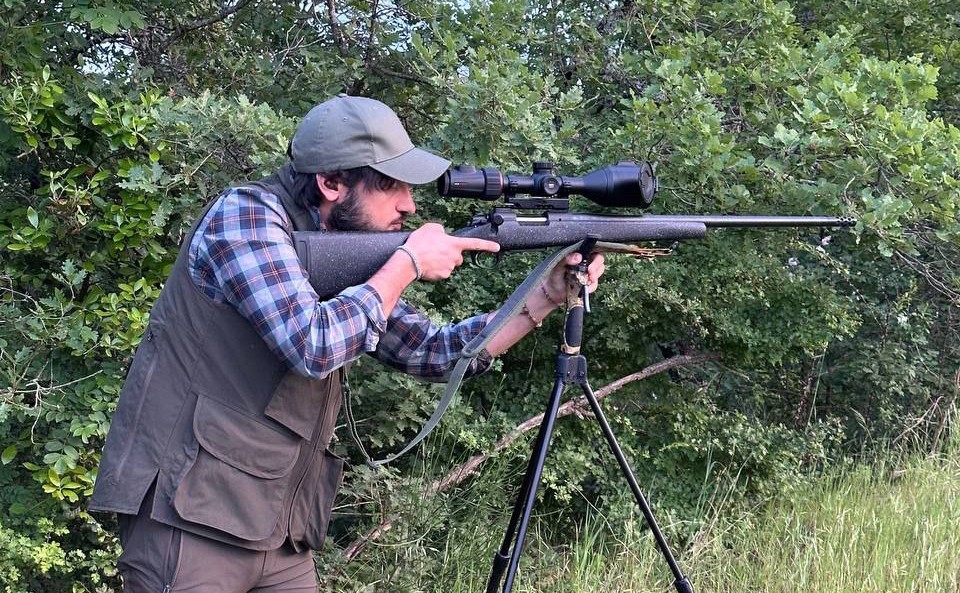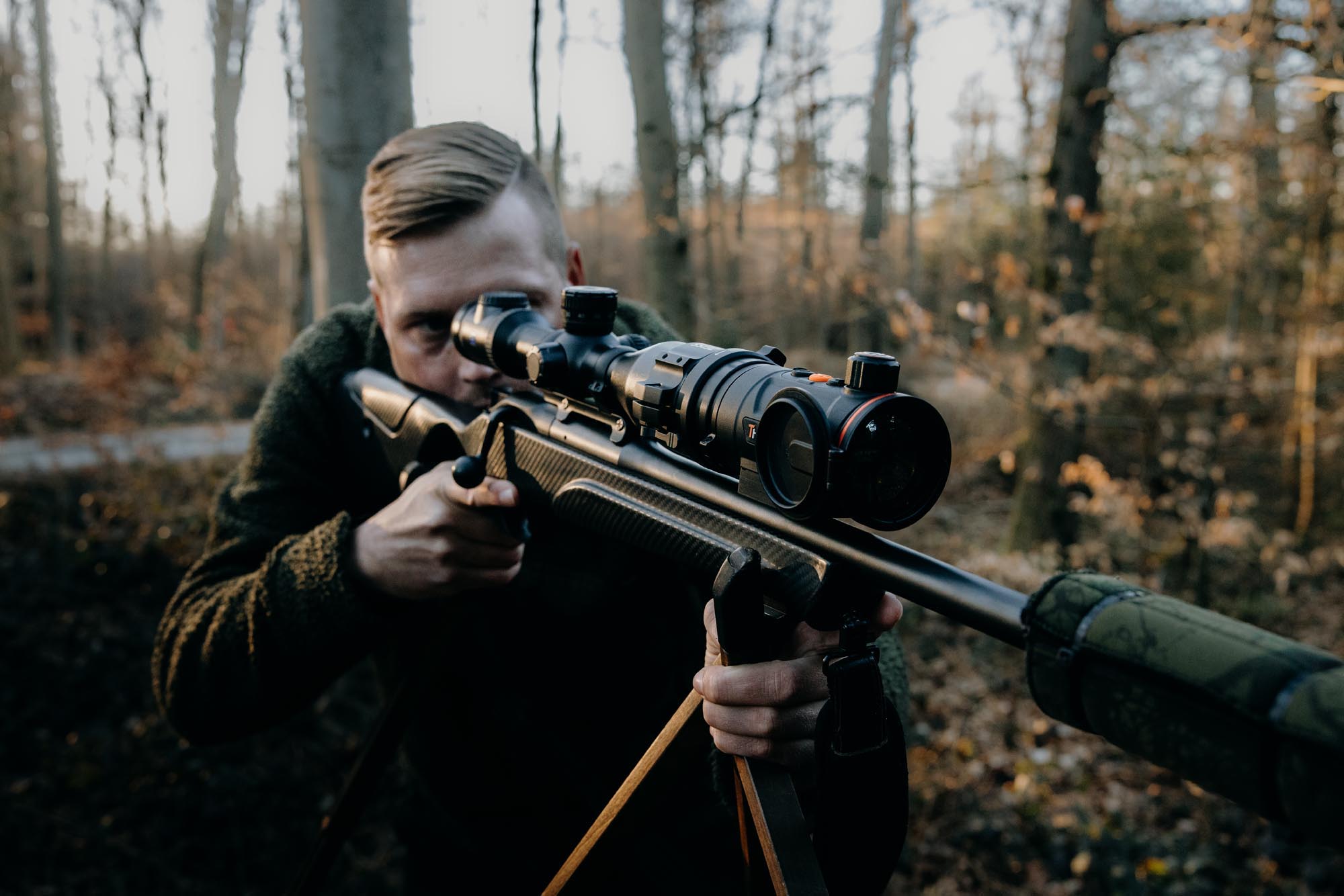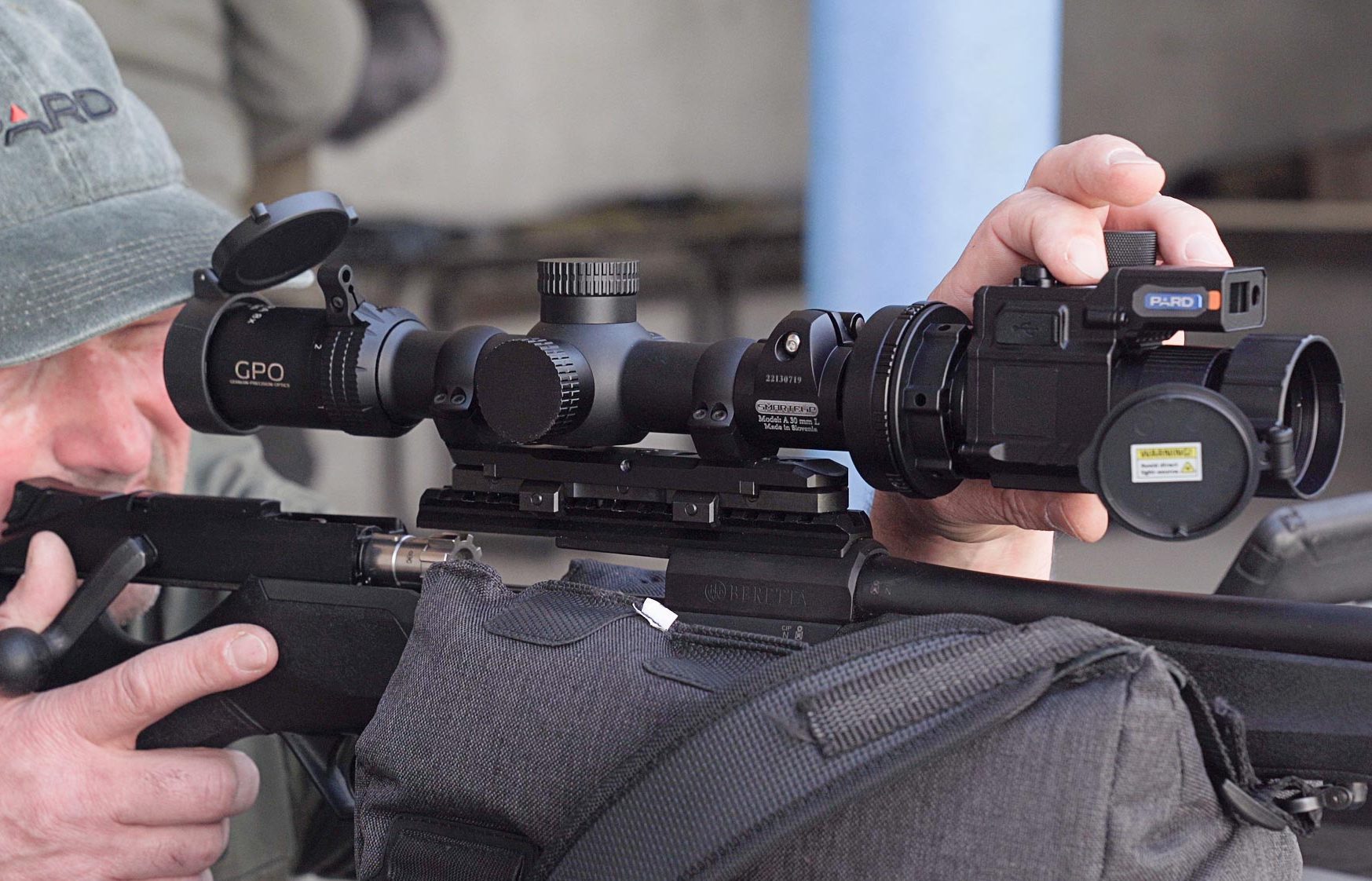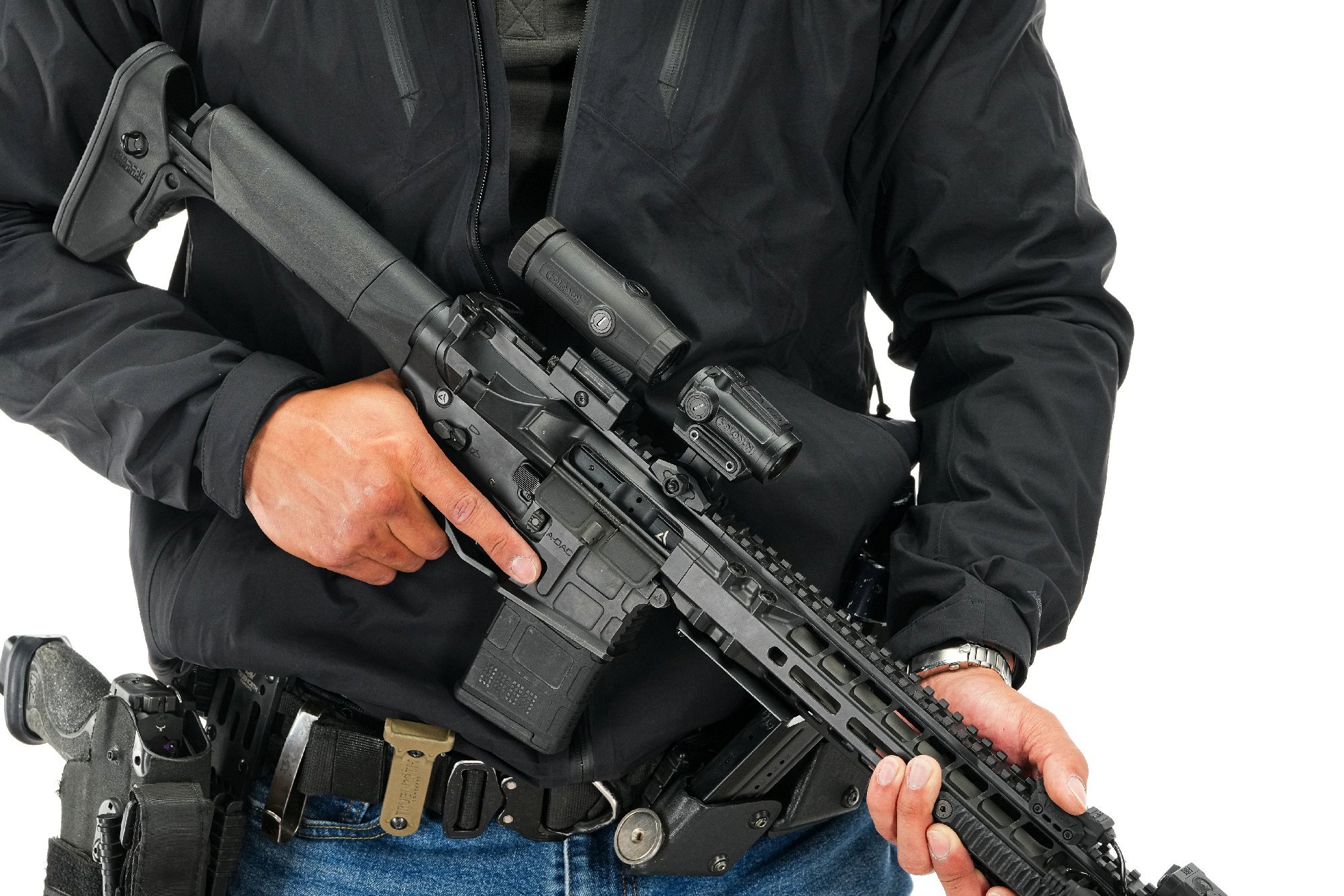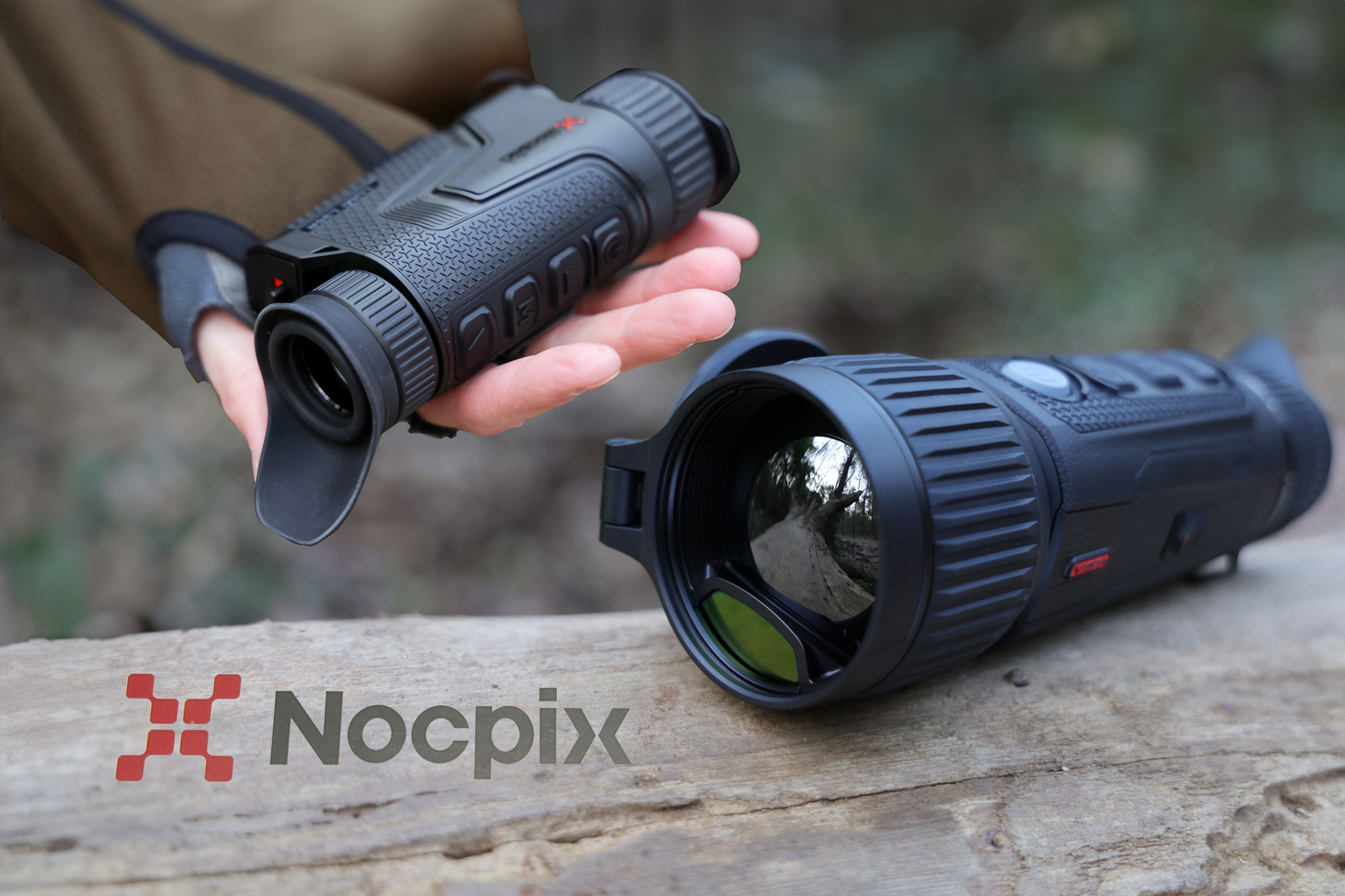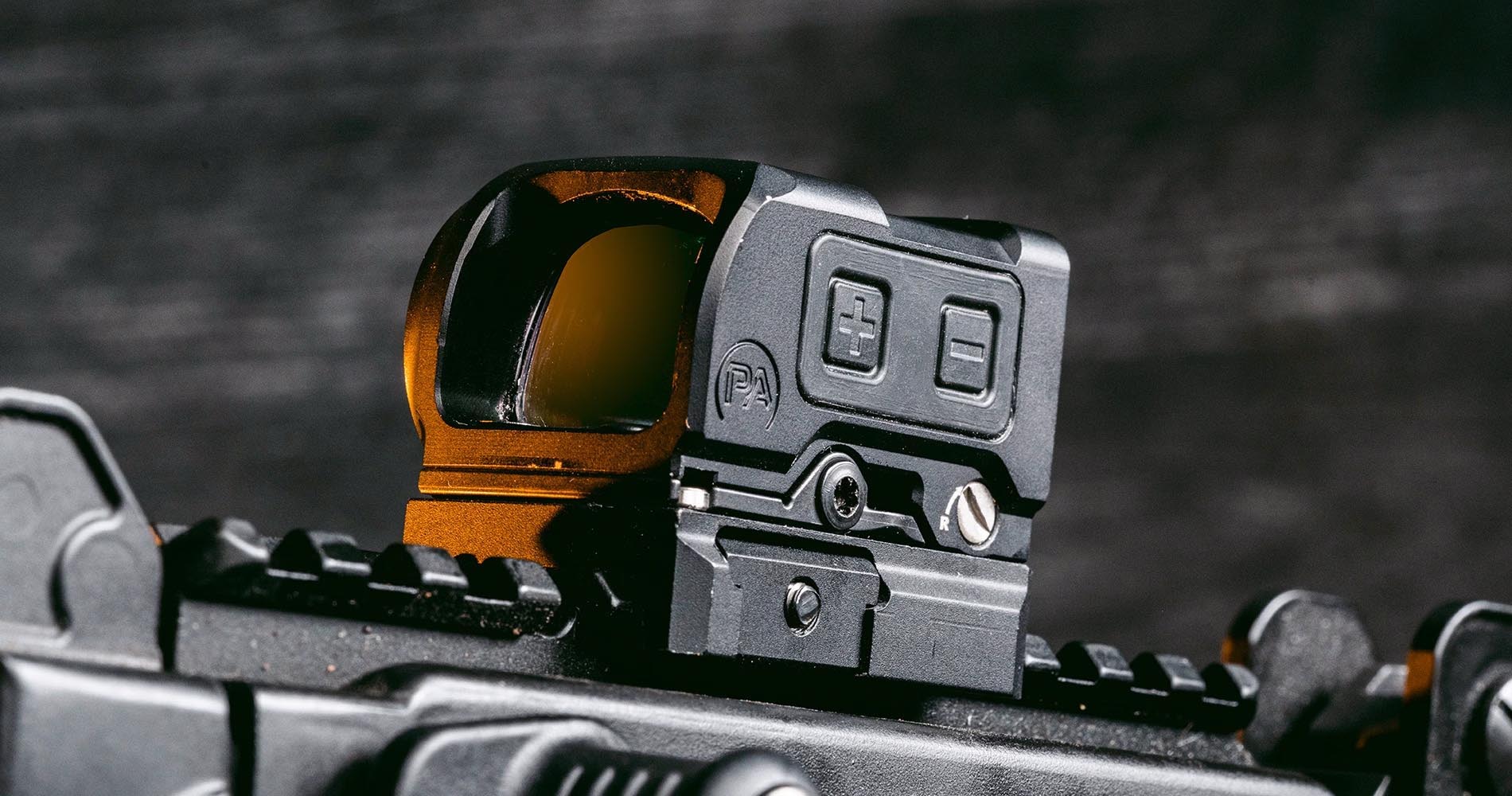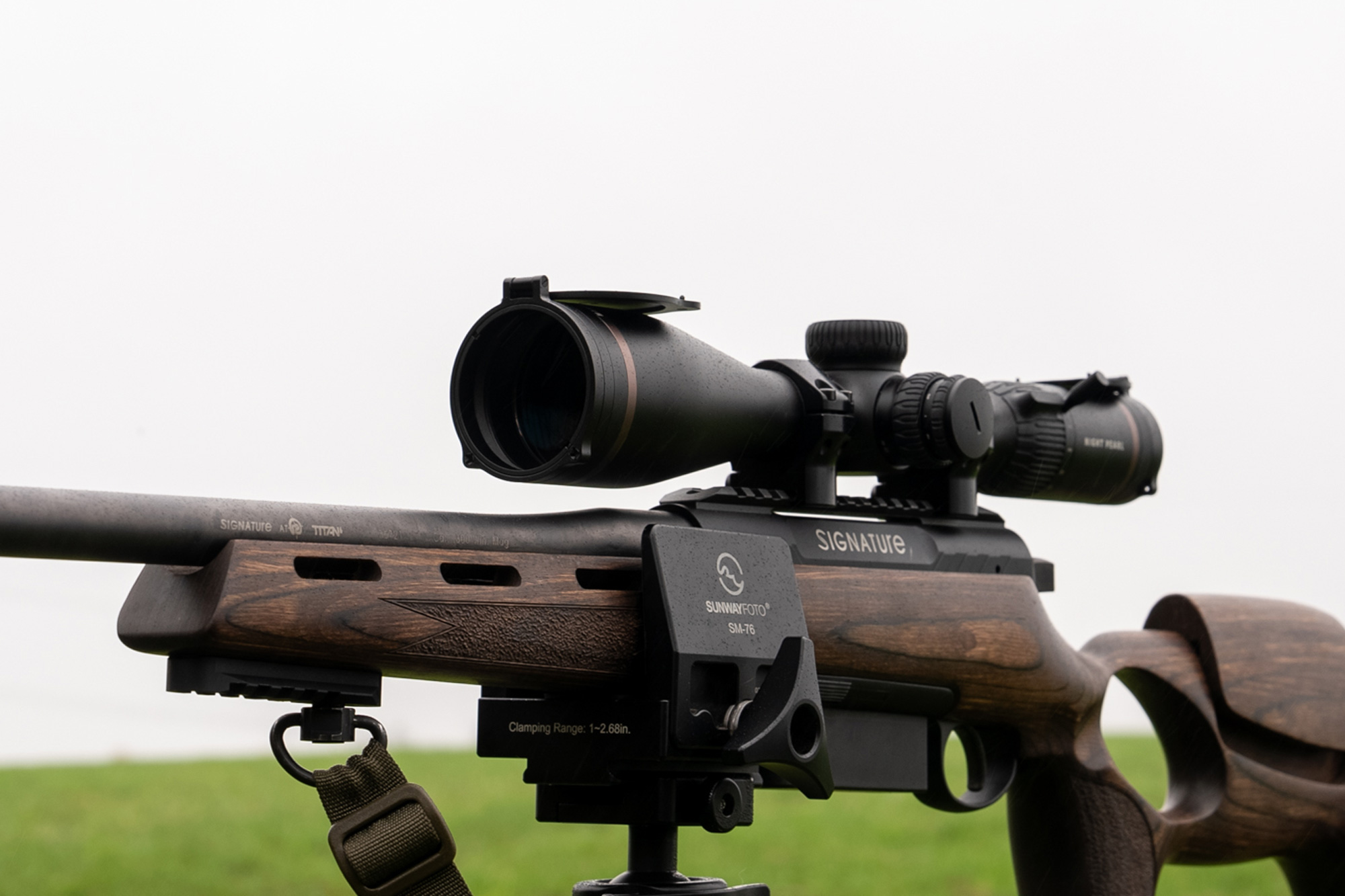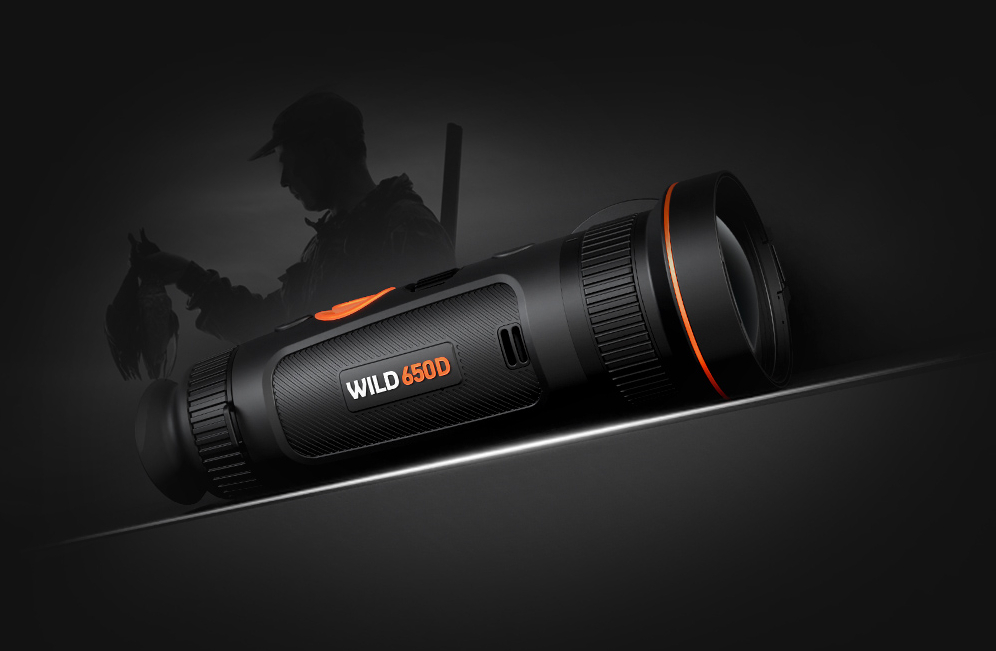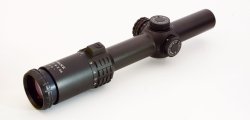
In our selection of test models – the 1-6x24 market offer of riflescopes is huge – we also took the price aspect into account and selected two inexpensive scopes and two upper price range optics. We chose Falke 1-6x24 L4a, Kahles K16i 1-6x24 SM1, Leica Fortis 1-6x24i L4a and Noblex NZ6 Inception 1-6x24 BDC. Driven hunt scopes are built for the specific demands that walked-up hunting presents. Not every boar goes trotting by: an elusive or highly elusive boar will reach speeds of 30 to 40 mph. Then the hunter must swing along and shoot ahead, depending on the range and angle of the escape route to the aiming position. There, the hunter's agility and judgment are required, and an illuminated reticle and large field of view are desirable. Dynamic sports shooting also has moving targets, but a large field of view is also an advantage for multiple static targets. Especially when the next target is already visible in the field of view. In addition, the athlete must not only shoot cleanly. Coordination, quick action, and lightning-fast position changes are required. Even then, a large field of view is helpful, because fractions of a second can be gained if the anticipation of the next target is supported by an overall picture.
Large field of view, both eyes open...
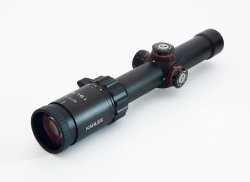
As the magnification factor decreases, the field of view increases. Therefore, if you want a large field of view, choose a low magnification. Magnification 1x is the order of the day when shooting with both eyes open. The field of view of binocular vision is 200 degrees, of which about 120 degrees are binocular. This means that in this field, the images seen by both eyes overlap. However, we see sharply only at an angle of about one degree. The farther an object is from the angle of optimal eye focus, the less accurate our perception becomes. Visual acuity has no absolute limit – it is a smooth transition. Although we do not see objects in the periphery sharply at all, we perceive moving objects in this area. The larger field of view due to bi-ocular shooting makes the task easier for both driven hunting and dynamic shooting. The four scopes tested all have 1x magnification.
Dominant eye and single-magnification riflescopes
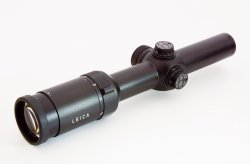
Now, one could argue that because of shooting with two eyes open, the field of view of the scope would be less important. After all, both eyes perceive the entire field at hand, including the view through the scope with the aiming eye. But this is not so: the dominant or leading eye is also the eye with which one aims. If you are right-handed, you will normally aim with your right eye as well. Since we concentrate with the right eye, we unconsciously suppress the influence of the left eye somewhat. Eyes and sight are very different in people and every now and then one weakens in terms of determining dominance. For this reason, Zeiss, for example, still promotes 1.1x magnification. This gives the aiming eye a somewhat higher priority. There is certainly some merit to this, but if you don't need it, then 1x – i.e. no magnification – is better. Also, with 1x magnification, you can decide for yourself and set the magnification a tad higher. Be that as it may, the field of view of the scope is important even with 1x magnification because it largely determines our image due to eye dominance. However, we still perceive the surroundings and if something moves here, our eyes immediately turn in that direction. So shooting with both eyes provides extra overview, safety and orientation.
"Eye box" and quick aiming
The "eye box" is an area behind the eyepiece where the shooter can position his aiming eye within a certain range of freedom of movement and always use the full power of the optical device. In this case, the image does not show any black spots or disturbing rings. In dynamic situations where fast target acquisition counts, this is a crucial thing. Below in Table 1 we have listed the important data. Often people are content with naming the exit pupil – very important in the vertical and horizontal planes. But if you shoot the rifle at lightning speed, you move three-dimensionally, i.e. also in the longitudinal direction. For this reason, the minimum and maximum distance of the eye to the outermost lens of the eyepiece is part of it.
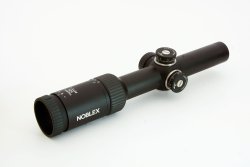
Table 1 shows the minimum and maximum distance from the eyepiece lens to the front of the cornea of the eye at 1x and 6x magnification. The Falke riflescope has a 15 mm margin in length at magnification 1x and 6x. However, the eye is one centimeter farther from the eyepiece at magnification 1x than at magnification 6x. The table is based on measurements with the tester's eyes and because the visual organs of Homo Sapiens are individually different, the data may change. For the first orientation, the diameter of the exit pupil is important. When the beam of light from the scope reaches your pupil, you should look for the center of the exit pupil, especially if the target is at a close range. Parallax errors are mainly observed at close range (15 to 60 meters). Almost all riflescopes that do not have parallax compensation are adjusted to be parallax-free at 100 meters. At other distances, they can only exclude parallax-related aiming errors if your pupil is positioned as close as possible to the center of the exit pupil. From experience, we know that inexpensive optics have many more parallax errors than expensive riflescopes from established manufacturers. For example, the Falke riflescope showed a deviation of up to 10 centimeters at 1x magnification at 25 meters and double that at 50 meters. The three other riflescopes performed much better here, with a deviation of only two centimeters at 1x magnification at 25 meters.
Field of view, exit pupil, lens diameter & zoom range
For close range, we want 1x magnification with a large exit pupil and field of view. However, if the optic is to be used at 300 yards and beyond, which occurs in dynamic shooting, then 8x or even 10x magnifications would be desirable. You can wish for a lot, but it must also be technically possible. An old rule of thumb is: objective lens diameter divided by magnification gives the exit pupil diameter. Accordingly, a riflescope with an objective lens diameter of 24 millimeters and a 6x magnification has an exit pupil of four millimeters. But by the same calculation, with the 24-millimeter objective lens diameter and a 1x magnification, would there be an exit pupil of 24 millimeters? No, normally this is around 9.5 millimeters. When using a 4x zoom range of 1-4x, an exit pupil of 14 millimeters at a field of view of 36 meters is normal. With a 1-8x24 scope set to 1x magnification and a field of view of about 42 meters, we have to be content with a good eight millimeters of exit pupil. So there is a connection between high zoom factor, large field of view and large exit pupil. If you want more exit pupil, then there is less field of view, especially if a large magnification range is involved. If you want a 1-8x24 scope, at 1x magnification you either have a smaller field of view or an exit pupil diameter smaller than the 9.5 millimeters that generally applies to the 6x magnification.
Table 1: Eye box of the four test riflescopes
| Eye
box in mm | Magnification 1x | Magnification 6x | Exit pupil | |||
minimum | maximum | minimum | maximum | 1x | 6x | |
Falke Hunt 1-6x24: | 80 | 95 | 70 | 85 | 17,5 | 4,2 |
Kahles K16i: | 80 | 105 | 85 | 100 | 9,5 | 4,2 |
Leica Fortis: | 80 | 105 | 80 | 95 | 12 | 4,2 |
Noblex NZ6 Inception: | 80 | 105 | 80 | 95 | 9,5 | 4,3 |
Test result: Falke 1-6x24 L4a – at a price of €499
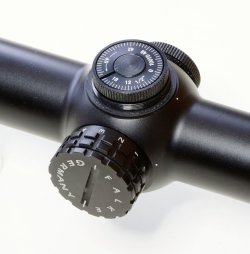
The affordable riflescope is intended for walked-up hunting. The crosshair adjustment dials are protected by caps, as in the other riflescopes. The dials are not suitable for quick adjustment. The markings are not visible from the eyepiece plane. The graduation marks are clearly visible, 60 clicks per revolution. The clicks cannot be heard or felt very well. As a sister model, they offer the Falke 1-6x24 Tactical with high adjustment turrets and Mil-Dot reticle. This makes it clear that a "dual purpose" concept is not being pursued, but rather two specialized optics are being offered for two areas of use. The La4 illuminated reticle has a 3-centimeter diameter dot at 6x magnification at 100 meters. Unfortunately, there is no tilt sensor and no automatic shutoff after a certain time. The reticle illumination dial has eleven levels. There is no intermediate setting where the illuminated dot is turned off. During driven hunts, the appropriate brightness is set to and then it costs halt life of the battery. In terms of field of view, it can't keep up with the competition with 29 meters at 100 meters (much less than the 33 meters the brochure promises). Surprising is the large exit pupil of 17.5 millimeters, which can be attributed to the comparatively simple lens system. This also increases parallax errors. The price of 499 euros fits the optic, although the riflescope with a quite-satisfactory-to-good optical quality also goes for significantly less money over the counter, depending on the seller.
Test result: Kahles K16i – at a price of approx. €1700
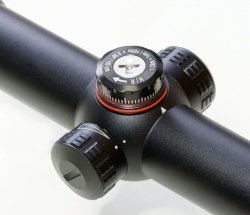
Originally developed for the military and law enforcement agencies, this riflescope also appeared on the civilian market in 2013. It is still a very high-quality, rugged optic with very good optical properties. The K16i offers a sharp, high-contrast image at all magnifications with good light transmission throughout the range. Although Kahles currently offers the new K18i 1-8x24, a riflescope designed specifically for dynamic sports shooting, the K16i still cuts a fine figure in this field. Of the three available reticles 3 GR, SI 1 and SM 1, we chose the latter version, which in our opinion can be used for sporting but also for hunting. Alternatively, of course, the Kahles Helia 1-5x24 hunting scope would be available with nearly identical optical performance, plenty of convenience ("Automatic Light") and a 4-DH reticle. However, this scope is not available with the SM-1 reticle. The horseshoe/dot reticle is designed for fast target acquisition. The illuminated dot has a diameter of 50 centimeters at 100 meters at 6x magnification, and the dot has a diameter of 1 MOA (just under three centimeters). As an inheritance of the original development, the reticle has a vertical line marking (one crossbar for every 0.5 mil at 6x magnification). This allows it to be used at longer ranges. However, the reticle illumination does not have an automatic cutoff and is immediately quite bright, so it is not suitable for twilight. It is primarily a riflescope for quick shooting and there it performs great.
Test result: Leica Fortis 1-6x24i – at a price of approx. €1695
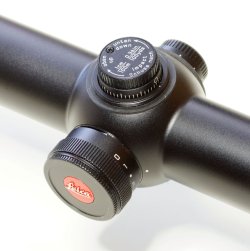
Leica promises a very large field of view and maximum exit pupil with the Fortis 1-6x24i, which is designed specifically for hunting use with the L-4a reticle. Due to the unique optical design with a so-called "Barlow" lens, the Fortis is said to feature a 50% larger exit pupil at 1x magnification. From the technical data (Table 2), it can be seen that the diameter of 12 mm is not 50% larger than that of the other test optics. Nevertheless, it is considerably larger than the exit pupil diameter of the other riflescopes. On the other hand, the field of view of 44 meters is truly record-breaking. The L-4a reticle is very finely designed for driven hunting with an illuminated dot that covers only 2.5 centimeters at 100 meters. However, the illuminated dot is very bright at the highest setting. State of the art, this riflescope is also equipped with an automatic shut off/on and a tilt sensor. After three minutes or at an angle of 75 degrees down, 40 degrees sideways, or 60 degrees up, the illumination shuts off. If the scope is moved or if the rifle including optics is brought into firing position, then the illumination is activated again. The fine reticle also allows precise shooting at medium ranges due to the low coverage. The light transmission of 92% is evidence of high quality for a driven hunt scope. The optical performance is very good, as you would expect from Leica. However, the Kahles K16i takes first place here because it has a slightly better resolution. In terms of mechanics, the optic can also be used in wind and bad weather conditions without any ifs or buts. The hunter never has to fear that the Fortis will fail its service on the hunting ground.
Test result: Noblex NZ6 Inception 1-6x24 – at a price of €695
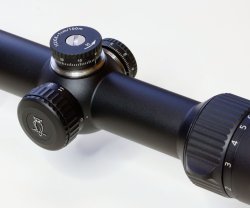
solutions and the question is whether zeroing is an option, because it is not mentioned in the instructions.
Since November 2020, the new name of the company is Noblex E-Optics GmbH. Of course, many products remain in the offer. The Noblex NZ6 Inception 1-6x24 doesn't quite match the levels of Kahles and Leica in terms of optical performance and field of view, but still offers plenty of confort with its automatic reticle illumination shutoff when inactive and tilt sensor with automatic activation when the rifle is resumed. The NZ6 Inception features a Bullet Drop Compensation (BDC) reticle designed for .308 Winchester caliber at 6x magnification. When the rifle is fired in at 100 yards, there are dashes per 100 yards to 600 yards. At two inches thick at 100 yards, the dashes do cover quite a bit of target area. We were surprised at the 310 centimeters of elevation and windage adjustment mentioned in the manual. In fact, we counted 725 and 720 clicks. Because we checked the effect of the adjustment with a collimator, we were able to determine that after 655 clicks of elevation adjustment and 650 clicks of windage adjustment, the dials clicked a funny 70 clicks more without the reticle adjusting. Now no one is going to use this huge adjustment total at all, but it is still unsightly. The Falke scope also had 5 "empty" clicks, but that is still acceptable for such an inexpensive optic. The "empty" clicks have no effect on the reticle adjustment, which has no flaws. All in all, the Noblex NZ6 Inception offers good value for money, as 695 euros is reasonable for a riflescope in the medium performance level but with all the comforts.
Full overview and prices: the scopes from Falke, Kahles, Leica and Noblex in detail (Table 2)
Riflescope: | Falke Hunt 1-6x24 | Kahles K16i | Leica Fortis | Noblex NZ6 Inception |
Length (mm): | 276 | 278 | 272 | 282 |
Length (mm)*: | 276 | 280 | 272 | 282 |
Weight (grams): | 510 | 480 | 540 | 525 |
Weight (grams)*: | 514 | 505 | 515 | 520 |
Main Tube Diameter (mm): | 30 | 30 | 30 | 30 |
Eyepiece Length (mm)*: | 98 | 98 | 100 | 105 |
Eyepiece Outer Diameter: | 46,5 | 46 | 48 | 46,5 |
Objective Lens Outer Diameter*: | 30 | 34 | 30 | 30 |
Magnification: | 1-6x | 1-6x | 1-6x | 1-6x |
Lens Diameter: | 24 | 24 | 24 | 24 |
Field of View (100 meters): | 33 - 5,5 | 42,3 - 6,7 | 44 - 7 | 39,8 - 6,3 |
Field of View (100 meters)*: | 28,5 - 5,3 | 42 - 6,8 | 44 - 7,1 | 37,5 - 6,1 |
Exit Pupil 1x-6x: | keine Angabe | keine Angabe | 12,4 - 4 | 9,6 - 4 |
Exit Pupil*: | 17,5 - 4,2 | 9,5 - 4,2 | 12 - 4,2 | 9,5 - 4,3 |
Diopter Adjustment Range: | +2 to -3 | +2 to -3.5 | +3 to -4 | +2 to -2 |
Interpupillary Distance (mm): | 110 - 88 | 95 | 90 | 95 |
Parallax Compensation: | No | No | No | No |
Parallax Free Adjustment (meters): | 91.44 | 100 | 100 | 100 |
Adjustment per Click (100 meters): | ½ inch1 | 1.5 cm | 1 cm | 1 cm |
Adjustment Range Height (100 meters): | 120 MOA | 220 cm | 400 cm | 310 cm |
Adjustment Range Height (100 meters)*: | 161 MOA | 213 cm | 457 cm | 655 cm |
Adjustment Range Width (100 meters): | 120 MOA | 220 cm | 400 cm | 310 cm |
Adjustment Range Width (100 meters)*: | 155 MOA | 217 cm | 453 cm | 650 cm |
Reticle: | L-4a | SM1 | L-4a | BDC-1 |
Reticle Illumination: | Yes | Yes | Yes | Yes |
Automatic Switch-Off: | - | - | Yes | Yes |
Tilt Sensor: | - | - | Yes | Yes |
Reticle Image Plane: | 2 | 2 | 2 | 2 |
MSRP: | 499 euro | 1700 euro | 1695 euro | 695 euro |
* Our own measurements, 1 Per click at 100 yards (91.44 meters). | ||||
The four 1-6x24 riflescopes: all4shooters.com test conclusion
The "double purpose" for hunters and sports shooters that we wanted at the beginning hardly exists with the 1-6x24 riflescopes. Technical progress is happening faster and faster, especially in the world of optics. Whereas years ago 1-6x lenses were the measure of all things in dynamic shooting sports, specialized riflescopes with 1-8x or even 1-10x magnification are now available. However, high zoom ranges are also enjoying ever-increasing popularity in hunting. Electronics are playing an increasingly important role and we will see an even stronger connection between optics and electronics in the future. But also an ever increasing specialization of riflescopes exactly to their intended use.
In our comparison test, the Kahles K16i emerged as the winner for sport use and the Leica Fortis as the winner for hunting. No wonder, since both models play in the premium class.
The other two test candidates from Falke and Noblex are priced in a completely different segment, but are worth real consideration for price-conscious buyers – especially when the additional price for "Premium" is a factor of 2-3 on the purchase price.



